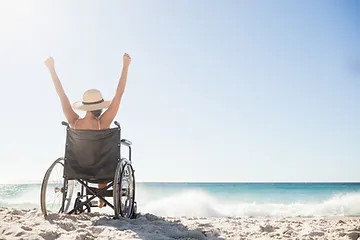Imagine for a moment that it is a sweltering hot day in Perth (which shouldn’t be too difficult), and your friends invite you to the beach, as they heard they have made it accessible and have beach wheelchairs for use.
Clear skies and sunshine, cool refreshing blue water, soft white sand, waves gently crashing against the shore… utter bliss. “Sure!” you exclaim, already excited to see our beautiful Indian Ocean, relaxing, and getting a tan.
To beat the midday peak, your friends say they will pick you up at 2, so you have an hour to get ready. You go about packing a beach bag and putting your bathers on. 2pm arrives, your friend’s pick you up and then you’re off!
That all sounds normal enough, right? Yeah. Except here is where it gets ridiculous.
Accessibility is not just a box to be ticked, it is something that needs to be addressed properly.
After parking, you and your friends make your way to the area that has special beach wheelchairs available, which you intend to swap your usual chair out for so that you can access the beach with ease and independence.
What you are horrified to find is a poorly written sign plastered to the door reading: CHAIRS ONLY AVAILABLE UNTIL 2PM.
Alright, so they have made efforts to be accessible yet have also placed a weird curfew on accessibility. Too bad if I was in school and wanted to go to the beach after 3pm. Your options now are to go home and miss out, your friends could carry you, but they know you don’t want that – being carried up the beach on a hot day might make feel like a burden, and it isn’t the most dignified way of getting there, especially as a 21-year-old.
The above situation is a real problem, which I recently learnt more about after attending a workshop hosted by Spinal Life Australia. This sort of story isn’t uncommon, and disgust doesn’t even come close to describing what I felt after hearing this story. With over 80 kilometres of sun, sea and sand to be enjoyed on Perth’s coastline we should be doing a whole lot better in this area.
It isn’t only people who use wheelchairs facing barriers at the beach. There are many other disabilities, such as blindness; no clear signage or Braille at the majority of beaches, no contrast on stairs leading to the sand which is a huge tripping hazard, and the list goes on.
So, what’s the point to this story?
The bottom line is that even though the Government has funds and roll out their commitment to equality, they choose to spend it on other things. Things like access and inclusion simply aren’t a priority. Accessibility is not just a box to be ticked, it is something that needs to be addressed properly. Placing limitations and rules that are convenient for the person without disability is not being accessible, it is not committing to the social model of disability.
Of course, this is only one of a thousand accessibility issues that society needs to fix. And yes, that’s right, I did say ‘society’ – society needs to take into consideration the needs of everyone when they build new things, and not just their idea of what an ‘average’ person is. They need to keep universal design in mind.
It’s not our fault that we have a disability – we never asked to have it. We are not ‘less than’ someone else, so why should we be afforded less access and opportunity in life because of it? I may sound entitled and indignant, and that is because I am – I’m sick of the exclusion our community faces.
So, what can you do to help?

